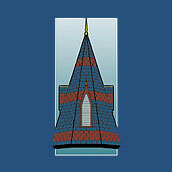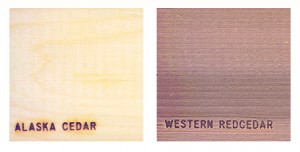Choosing A Wood Roofing Shingle
Alaskan Yellow Cedar vs Western Red Cedar
Scott Donahue —
Some twenty five years ago I began to become disenchanted with the quality of the Western Red Cedar shingles that were being made available in the Connecticut market. Western red cedar had long been considered the standard bearer for wood roofing in New England. It had gained the reputation for being a roofing material that not only provided a pleasing aesthetic, but for being a product that was durable, with life expectancies often exceeding well over 30 years.
What became apparent to me was that the shingles being distributed were of a quality that was being compromised by accelerated growth. You could see it in the grain of the shingles. I learned that the trees were being cultivated in a manner that diminished the density of the wood and therefore diminished the quality of the wood shingle and ultimately the quality of the wood roofs that we were hired to install. As a wood roofing contractor my reputation was at risk by association.
At the time there weren’t readily accessible alternatives to Western Red Cedar roofing shingles in our market, and as a result I changed my marketing focus. I altered my attention from wood roofs, to alternative high end products such as slate, clay tile, and copper roofing. However wood roofing opportunities continued to present themselves, and when they did I would caution my customers against unrealistic expectancies or roof life expectancy, and I would urge them to consider higher grade shingles, in heavier thicknesses, sourced only from the mills with a reputation for stricter grading standards. Additionally I advocated for pressure treated shingles, stainless steel fasteners, and alternative installation methods that facilitated more air circulation beneath the wood shingle installation.
In 1998 I had my first introduction to Alaskan Yellow Cedar. It was brought to my attention by my shingle vendor at Anglo –American Cedar Products in British Colombia. I had often voiced my concern to him about the quality of the Western Red Cedar that was being made available in my market. He was eager to educate me about the newly available Alaskan Yellow Cedar. Commonly referred to as “AYC”, and technically a member of the cypress family, it is an old growth product; dense, extremely hardy, and very durable. I was immediately impressed by it, and to this day I continue to be a proponent.
When comparing Alaskan Yellow Cedar and Western Red Cedar the cost is comparable, but from a longevity standpoint it’s not a fair fight. Alaskan Yellow Cedar is simply a more durable product than its Western Red Cedar counterpart. While it’s difficult to definitively quantify how much longer you can expect an Alaskan Yellow Cedar roof to last, however I believe it to be a minimum of 25 percent and arguably much more than that. Aesthetically the two roofing choices are different from a color perspective, Alaskan Yellow Cedar lightly silvers, and then darkens to a silvery grey. Western red cedar silvers , then progressively becomes a darker brown.


